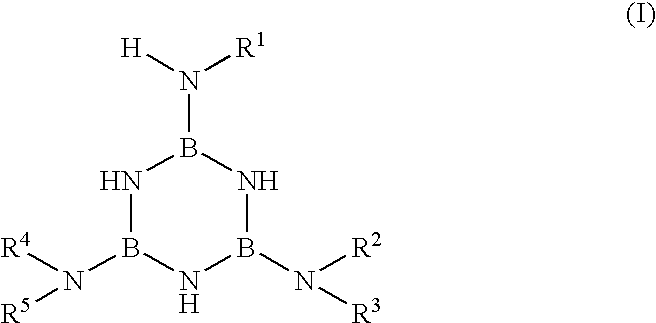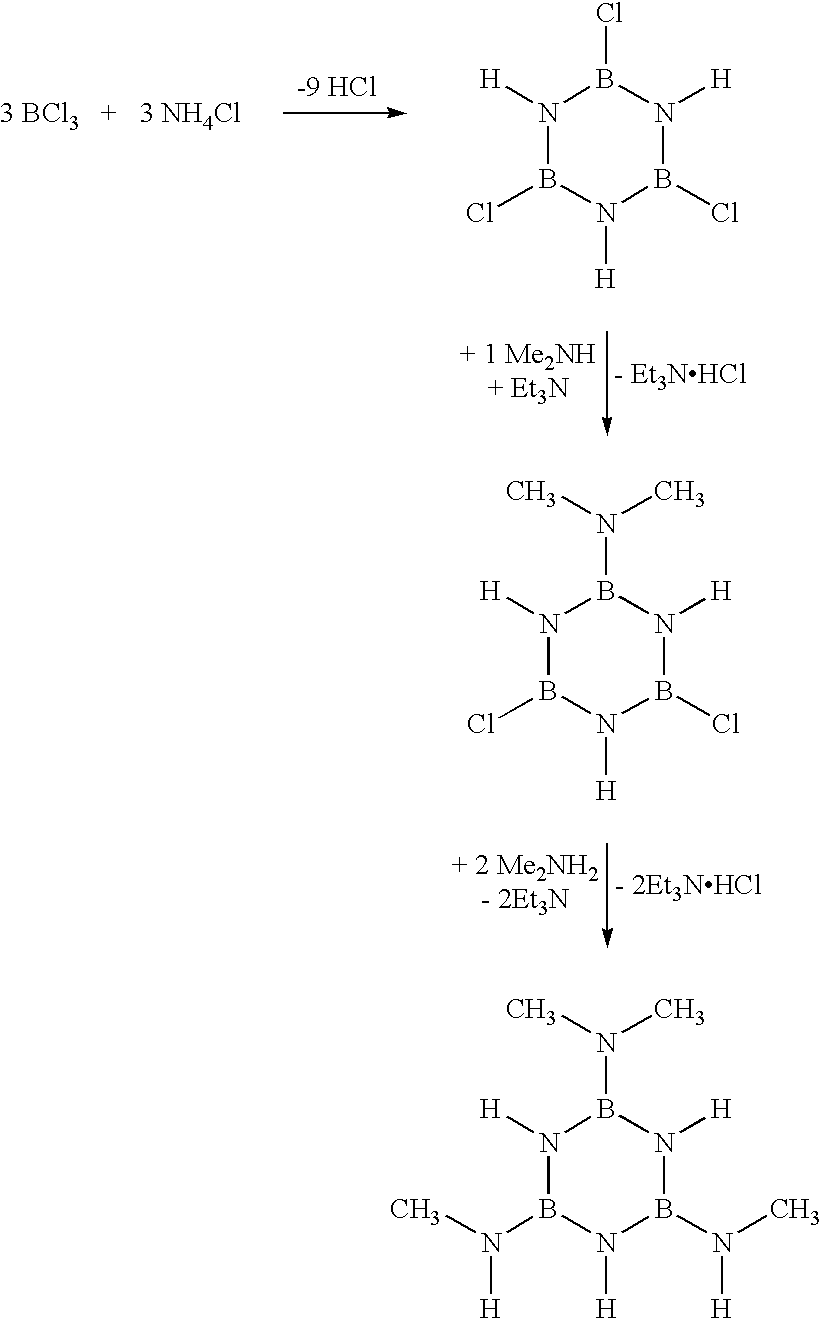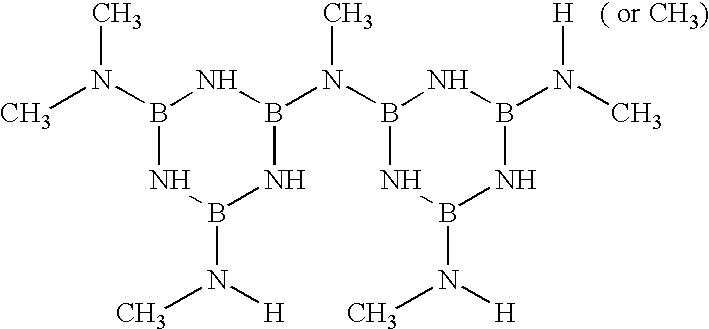Method for making boron nitride fibers from aminoborazines
a technology of boron nitride and aminoborazines, which is applied in the field of process for manufacturing boron nitride fibres, can solve the problems of difficult preparation of more complex forms, drawn precursor polymer necessary for shaping fibres, and difficult to prepare fibres from this type of polymer,
- Summary
- Abstract
- Description
- Claims
- Application Information
AI Technical Summary
Problems solved by technology
Method used
Image
Examples
example 1
Synthesis of [2,4-bis(monomethylamino)-6-dimethylamino]borazine
This borazine is obtained starting from trichloroborazine (TCB) by the addition of a dimethylamine equivalent for a TCB equivalent and then, after reaction, the addition of two monomethylamine equivalents, corresponding to the following reactional diagram: ##STR2##
Synthesis is done in toluene. The dimethylamine is cryopumped in a TCB / toluene / Et.sub.3 N solution (0.30 M in TCB) and the reaction mix is then adjusted to the temperature of an acetone / ice bath at -10.degree. C. for 5 hours, and stirring is then continued for another 19 hours. The same procedure is then continued with monomethylamine using two monomethylamine equivalents for one TCB equivalent. The next step is to filter the reaction mix, and the solvent is then evaporated under a vacuum. The result is then a light orange viscous product containing about 5% of toluene by mass. The product is characterised by multi-radicals, infrared NMR and chromatography by g...
examples 2 to 5
Polymerisation of [2,4-bis(monomethylamino)-6-dimethylamino]borazine
In these examples, the first step is to vacuum dry the monomer at a temperature of 50 to 80.degree. C., and polymerisation is then carried out under an argon atmosphere using different temperature programs.
The temperatures and durations used for polymerisations are given in table 1. The next step is to determine the resulting polymer mass, the polymerisation rate, in other words the number of moles of nitrogen atoms released in the form of aminos per aminoborazine mole, the average molar mass of polymer and its vitreous transition temperature Tg.
Polymerisation conditions and the results obtained are given in table 1.
Thus, it will be noted that the vitreous transition temperatures of polymers are not more than 90.degree. C. and their average molar masses are of the order of 780 to 1000 g / mol.
examples 6 to 17
In these examples, spinning, and then ceramisation of the polymers obtained in examples 2 to 5 are carried out. For spinning, a piston with a diameter of 9.98 mm moving at a speed within the range from 0.8 to 1.3 mm / min, and a nozzle with a diameter of 200 .mu.m, are used. The spinning temperature varies from 137 to 192.degree. C. At the exit from the nozzle, the fibres are wound onto a graphite reel with a diameter of 50 mm in examples 6 to 14, and onto a graphite reel with a diameter of 100 mm in examples 15, 16 and 17. The spooling speed can vary from 1.5 revolutions / second to 25 revolutions / second.
Spinning conditions and the initial polymers are given in tables 2 to 4. After spinning, the polymer fibres are ceramised under the conditions described below.
Ceramisation A:
a) Preceramisation: heat up to 600.degree. C. at a rate of 25.degree. C. / h, under NH.sub.3.
b) Ceramisation:
Heat from 600 to 1100.degree. C., at a rate of 100.degree. C. / h under N.sub.2.
Hold at 1100.degree. C., unde...
PUM
| Property | Measurement | Unit |
|---|---|---|
| Angle | aaaaa | aaaaa |
| Angle | aaaaa | aaaaa |
| Angle | aaaaa | aaaaa |
Abstract
Description
Claims
Application Information
 Login to View More
Login to View More - R&D
- Intellectual Property
- Life Sciences
- Materials
- Tech Scout
- Unparalleled Data Quality
- Higher Quality Content
- 60% Fewer Hallucinations
Browse by: Latest US Patents, China's latest patents, Technical Efficacy Thesaurus, Application Domain, Technology Topic, Popular Technical Reports.
© 2025 PatSnap. All rights reserved.Legal|Privacy policy|Modern Slavery Act Transparency Statement|Sitemap|About US| Contact US: help@patsnap.com



